
LiteCoin 101: A Beginners Guide
Since the establishment of Bitcoin in 2009, many different cryptographic forms of money have entered the scene. It has become hard for advanced coins to stand apart given the degree of competition in the field. Litecoin (LTC) is one non-Bitcoin crypto which has figured out how to face the opposition. LTC presently drags along Bitcoin as the seventh biggest advanced cash by market, as of August 2020.
In contrast to most other alternative cryptocurrencies, or "altcoins." Litecoin costs beat Bitcoin for many years after the release. It establishes its place as one of the world's most popular cryptographic forms of money. Charlie Lee, a former Google and Coinbase engineer founded LTC. He used the Bitcoin codebase for LTC but with an increased number of coins. It has a speed at which new blockchains are added. With LiteCoin, you can make instant payments to anyone in the world. Also, using consumer-grade hardware, you can mine LTC efficiently.
How LiteCoin Works:
Practically speaking, we can think LiteCoin as a Bitcoin quarter. Its total supply is multiple times higher than Bitcoin. It is multiple times quicker, making it an alt coin that is more efficient to execute in comparison to Bitcoin. LTC was released under the MIT/X11 license. The creation and transfer of coins use an open source cryptographic protocol and is not decentralized.
The main drawback of Litecoin is its absolute anonymity. This creates a bad image for the coin, as DarkNet used it for illegal things. Since the introduction of the Litecoin professional mining machine, there are many reports that in the presence of mines, the computing power once exceeded 50% of the total network computing power, resulting in uneven distribution. Litecoins are still somewhat unknown, unlike Bitcoins. This is mainly due to being no central Litecoin authority and as of now, the largest virtual currency trading websites still don’t support Litecoins.

Defining Features:
Speed
Litecoin depends on a similar open-source code behind Bitcoin, with some minor differences. Made by engineer Charlie Lee to be the silver to Bitcoin's gold, one of the primary contrasts between the two cryptographic forms of money is the exchange speeds.
Number of Coins
One of the reason why some cryptocurrencies hold inherent worth is a direct result of their restricted supplies. When a specific number of bitcoins (BTC) or Litecoins (LTC) are made, that is it. No more new coins can be made. Bitcoin has a constraint of 21 million coins, yet Litecoin maximises at 84 million.
Market Cap
In spite of the fact that the market cap fails to measure up Bitcoin, Litecoin still positions among the best five digital currencies. These rankings vary dependent on cost and number of coins available for use.
Is Litecoin a good investment?
Perhaps one of Litecoin’s biggest advantages is the fact that confirmation times can be much lower on the network. Transactions can be submitted and processed much faster given that a block is verified every two and a half minutes. This is four times faster than Bitcoin’s current offer of 10 minutes.
Those in favor of Litecoin investing point to how this blockchain is more scalable than the likes of Bitcoin and Ethereum. Whereas BTC can handle roughly seven transactions per second, and ETH can muster 15, LTC is able to process 56 TPS at peak times. As a result, some suggest that Litecoin is more practical option for retail purchases – both in terms of capacity and ensuring that the merchants can get their payments confirmed in the shortest time possible.






Leave a Reply
26 comments
Add comment ×